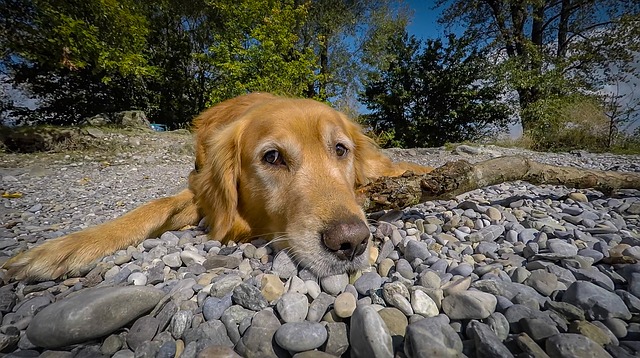Ever stumbled upon your pretty pup eating dirt, rocks, and other odd things one too many times?
Your pup could be suffering from canine pica, a compulsive eating disorder where a dog eats non-food items regularly.
Canines with this problem often chew on rocks, paper, dirt, flaking paint, grass, and even feces.
Canine pica is best dealt with as it can lead to choking, poisoning, gut blockages, and other issues.
If you catch your pup constantly chewing on rocks, dirt or non-food items, you need to take action and address the issue as soon as possible.
So, what can you do to stop the behavior?
Well, if you are a new dog parent or if it is your first time to witness such behavior in your dog, you may find it a bit challenging to make him/her stop.
To help you out, I will explore simple, natural steps that you can leverage to stop your dog from eating non-food items.
Before then, it is important to have a clear understanding of what is considered pica in dogs and what causes it.
If we know these basics, we will be in a position to understand better how each of the remedies that we’ll discuss herein can help our canine companions.
What is Pica?
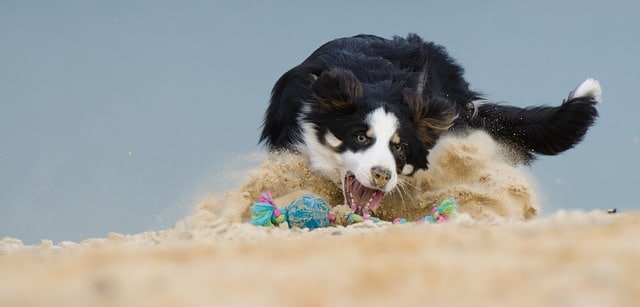
As hinted above, pica is an eating disorder that’s often characterized by the urge to consume objects that are non-food items like rocks, plastic, dirt, cloths, metal, paper, garbage, or even feces.
Speaking of feces, you shouldn’t confuse pica with coprophagia, which is a technical term for the tendency to eat feces.
Coprophagia is common in puppies but may be carried into adulthood. It is thought that some puppies find fecal matter appealing or simply like the flavor of feces, which makes it a hard habit to break once a puppy gets started.
So, while coprophagia is a form of pica in dogs, it cannot be strictly classified as pica.
Simply chewing on non-food items isn’t necessarily pica. A dog needs to ingest the non-food item for it to be considered pica.
Causes of Pica in Dogs
The main causes of pica in dogs can be categorized into two distinct groups: psychological (or behavioral) and physiological (caused by underlying medical conditions).
Behavioral causes of Pica include stress, boredom, and anxiety (especially separation anxiety).
Other common behavioral causes include:
- Attention-seeking
- Lack of physical and/or mental stimulation
- Depression
- Lack of socialization
- Frustration
The most common underlying medical conditions that may trigger pica in dogs include:
- Nutritional imbalances
- Endocrine diseases (such as diabetes and thyroid diseases)
- Hookworms intestinal parasites
- Immune-mediated hemolytic anemia (IMHA)
- Neurological issues
- Iron deficiency anemia
- Inflammatory bowel disease (IBD)
- Stomach tumors
- Liver disease
- Adverse reactions to rabies vaccination
- Side effects of medications (like anti-seizure and steroid-based medications)
- Teething in puppies
Top 10 Natural Remedies for Pica in Dogs

Now that we understand fully what pica is and its potential causes, let’s shift our focus to some of the natural remedies that you can use to stop the behavior.
(By the way, the condition rarely goes away on its own. It is often a compulsive behavior irrespective of the cause. )
Now, if the condition is a result of an underlying medical condition, treating the specific medical condition may just be enough to get rid of the pica behavior.
But there are circumstances when pica may develop into a bad habit, especially if your dog has been eating non-food items for long.
In such situations, treating the underlying health condition may not solve the problem and you may need to take extra measures to help treat and prevent the condition.
These include:
1. Ensure Your Dog Gets Plenty of Physical and Mental Stimulation
Enough physical exercise should always be part and parcel of your dog’s daily routine to mitigate boredom and destructive behaviors.
So, giving your dog good physical exercise (at least 60 minutes a day) may be all he needs to stop eating non-food items.
Know your dog’s age, breed, and lifestyle to figure out the amount of exercise that he needs. Sporting and hunting breeds, for instance, may need more exercise and mental stimulation than toy breeds.
Exercise should include mental stimulation too.
So, if you notice that your dog indulges in pica at a particular time of the day, consider diverting his attention by teaching him new tricks or giving him puzzle toys to work on.
2. Eliminate Your Dog’s Access to Objects That He May Ingest
Whether the cause of the behavior is psychological or medical, limiting the dog’s access to objects that he constantly eats can go a long way in eliminating this harmful behavior.
If your dog loves eating rocks, for instance, keep him out of rocky areas or parks.
In case you feel that this is too restrictive, always have more attractive treat options—such as Kong—when your dog is in rocky environments.
You can also opt for a basket muzzle in extreme cases but you need to ensure that the muzzle doesn’t limit your dog’s ability to breathe. It is not also advisable to let your dog wear the muzzle for long.
When it comes to basket muzzles, we always recommend this Nylon option from Crazy Felix store.
It comes with a practical closed part under the chin, which is effective in preventing your dog from eating unwanted items.
It is also breathable and features black coloring, which can go a long way in helping your pup stay cool.
Alternatively, leash-walk your dog when you are going to areas or parks with items that he likes ingesting.
3. Dietary Changes
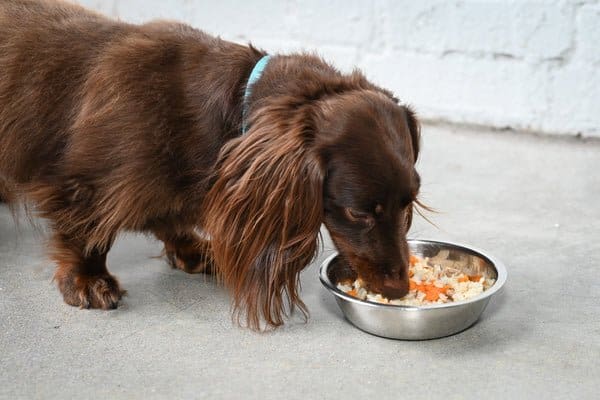
If your dog is eating non-food items, he could be looking for certain nutrients lacking in his food.
Perhaps the diet doesn’t have sufficient minerals, probiotics, or vitamins.
If this is so, you may need to make some dietary changes to ensure that your dog’s meals are nutritionally-balanced.
Consider adding digestive enzymes to your dog’s diet to help him absorb nutrients better.
It is also important to think about whether your pup is getting enough food since the pica problem could boil down to your pup being hungry.
Perhaps a simple move like feeding your dog more food may just resolve the issue.
Remember to spread the meals throughout the day for better results.
For instance, 3-4 small meals spread throughout the day are psychologically easier for your dog’s body to digest and assimilate than 1-2 larger daily meals.
4. Eliminate Environmental Stressors
Another quick way of resolving pica behavior in dogs is to eliminate potential stressors in your dog’s environment.
If your kids might be interacting inappropriately with your dog, for instance, ensure that the dog gets regular breaks from the kids and that your dog has a place he can go where there the kids can’t reach him.
If your dog gets agitated when your neighbor is mowing his loan, consider keeping him inside your house or taking him on an adventure away from the noise of the loan mower.
And when the dog gets nervous when you play loud music, consider turning down the volume or wearing headphones.
Providing regular schedules for your dog may also help. Regular feeding times walks, and playtime may also assure your dog that things are coming as they always do and can decrease his anxiety.
5. Keep Him Occupied with Chew Toys
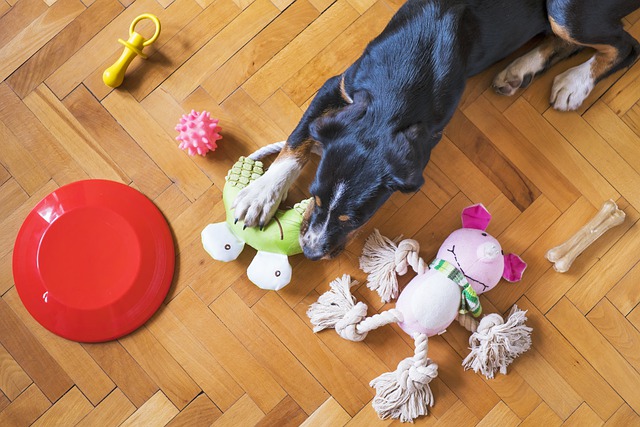
Giving your dog durable chew toys can go a long way in diverting his attention from objects that he may want to ingest.
Chews toys will also give your dog an opportunity to deal with stress and boredom.
See, the way you exhibit a strange behavior due to boredom or stress is the same way your canine friend can act out when going through the same behaviors.
Remember to rotate the type of chew toys that you give your dog on regularly to keep him engaged and challenged.
Related:
8 Best Chew Guard Technology Dog Toys
When Do Puppies Stop Chewing Everything?
6. Organic Deterrents
In situations where you cannot remove every item that your dog likes to chew in his vicinity or if the above strategies aren’t working, you may try deterrents.
These are products (like sprays) that are designed to be bitter for your dog, preventing him from chewing or eating inedible items.
There are several deterrents available on the market that you can safely use to deter your dogs from ingesting non-food items.
We always recommend that you pick organic varieties because most are not formulated with chemicals that may derail the health of your dog.
7. Give Your Dog Enough Attention
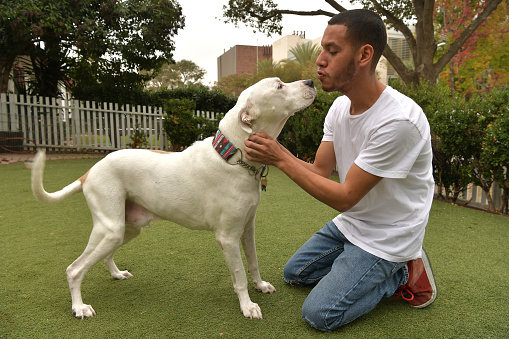
If you realize that your dog may be eating non-food items to get your attention, being proactive with the attention that you give him may lessen his desire to indulge in the behavior in the first place.
Like human beings, our canine companions love company. As such, leaving your dog for more than 4 hours alone is unkind and unfair.
Ensure that your pup doesn’t feel over lonely and is not left alone for too long during the day.
If you plan to be away for an extended period, consider taking your pup to a local doggy daycare.
Related:
12 Dog Breeds That Can Be Left Alone For 8 Hours
How Long Can You Leave A Dog Alone Legally (in the US?)
8. Be Calm and Understanding
Eating inappropriate items may be your dog’s way of communicating with you or the people around him.
So, it is not only important to try and connect with him but also to remain calm and understanding to show him the right direction to follow.
Most importantly, don’t be tempted to punish your dog for ingesting inappropriate items.
Avoid yelling at him as well as this may make him swallow things that he was probably going to chew.
It may even reinforce the bad behavior as the dog may see it as a fun game and a quick way to get your attention.
9. Behavior Modification Training
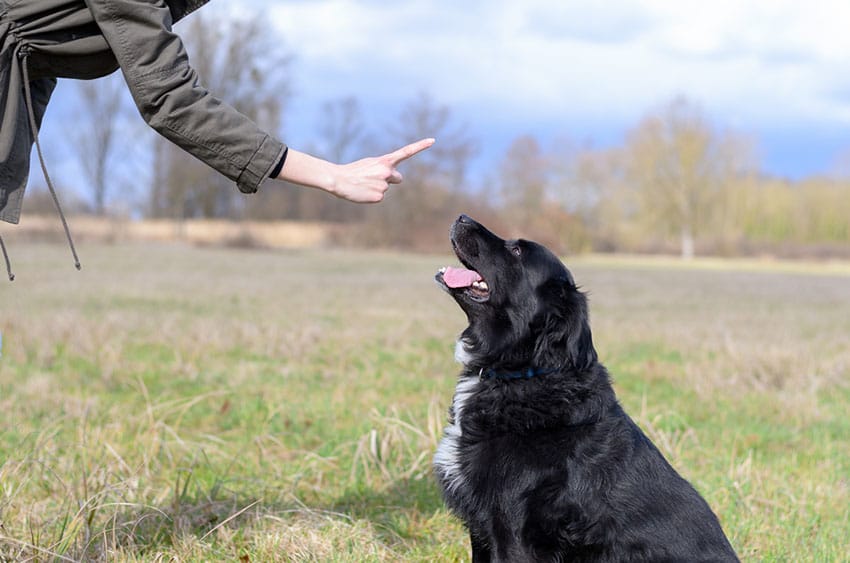
Puppies tend to put everything in their mouths due to their exploring nature.
It is part of their normal life cycle and most outgrow this phase. Learn more here: When Do Puppies Stop Chewing Everything?
However, adult dogs that develop pica need behavioral intervention—and that’s where behavior modification training comes in.
Balanced behavioral training and positive reinforcement can go a long way in preventing pica behavior depending on your dog and your training skills.
In fact, the pica behavior can be used as a cue to help the dog do something better.
For instance, it is possible to train your dog to learn that if he seeks inedible objects, he is going to get a treat if he turns around and goes to the house.
If done properly, it can be a good way to manage the pica behavior because it gets you (the owner) out of the picture and teaches your pup to make decisions himself.
If you are not sure of the best way to train your pup to stop eating inedible items, then you may need to hire the services of a dog trainer or veterinary behaviorist to help you.
10. Work with your Vet
Successful treatment of pica behavior may require you to work closely with your vet to identify the root cause of the behavior and to help you design appropriate ways of managing the condition.
Your vet may also refer you to a veterinary behaviorist or competent dog trainer who is qualified to address the behavioral issues that your pup may be facing and recommend you the most appropriate anti-anxiety solutions if necessary.
Treatment of Pica in Dogs Is an Ongoing Process

Pica behavior is not welcome news to any pet owner.
The constant worry that your four-legged friend could be sick not to mention the possibility of respiratory or gastrointestinal blockage is not pleasant.
But the good news is that pica in dogs can be managed.
However, if the cause is behavioral, it can be more challenging to manage.
So, treating such a variant of pica require dedication and commitment for the best outcome for you and your fur baby.
But with time and patience, there is absolutely no reason why you can’t manage pica in your dog.
If anything, a long-term commitment to manage the condition is certainly better than a life-threatening illness and emergency surgery that your dog may undergo to remove foreign material from his digestive tract.
You may also want to check: Can Dogs Die From Eating Rocks?
As an Amazon Associate, we may receive a small commission from qualifying purchases but at no extra cost to you. Learn more. Amazon and the Amazon logo are trademarks of Amazon.com, Inc, or its affiliates.

